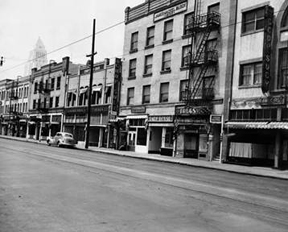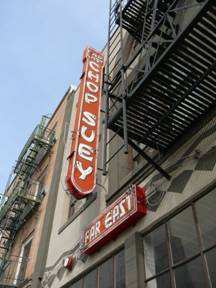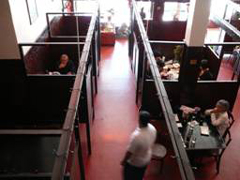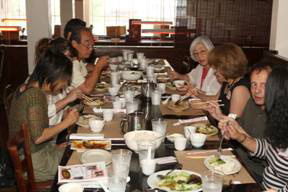
| What is Flavor and Fortune? |
| How do I subscribe? |
| How do I get past issues? |
| How do I advertise? |
| How do I contact the editor? |
Read 13027861 times
Connect me to:
| Home |
| Articles |
| Book reviews |
| Letters to the Editor |
| Newmans News and Notes |
| Recipes |
| Restaurant reviews |
| Article Index (all years, slow) |
| List of Article Years |
| Article Index (2025) |
| Article Index (last 2 years) |
| Things others say |
| Related Links |
| Log In... |
| Authors |
| Categories & Topics |
Far East Café and China Meshi
| by Raymond Douglas with Osumi, Tony Chong |
Chinese Food in the USA
Spring Volume: 2009 Issue: 16(1) page(s): 15, 16, and 17
The storied California FAR EAST CAFE at 347 East First Street in Los Angeles evokes sentimental nostalgia among many Chinese, Japanese, and others living in that city or those that visited there. They may recognize the former menu shown on this page because for fifty-nine years, this famous chop suey joint served the popular 'China-Meshi' better known as Cantonese cuisine. They did so in the landmark Far East Building in Little Tokyo's Historic District Downtown. Also serving China-Meshi were Lem's Café, San Kow Low, and Yet Quong Low Chop Suey Café (aka Nikko Low).
 Four Jung cousins, Chinese immigrants, opened this eatery during the heydays of Little Tokyo. They were from Hoy Ping County, Kwangtung Province, China. Before opening this restaurant they were operators of the Le Chung Brothers Chinese Hand Laundry in Mason City, Iowa. Now their Far East Café was near the Civic Center complex and a popular destination of City Hall politicians such as Mayor Thomas Bradley. Also frequenting it were Hollywood stars including Anna May Wong. She was present at their opening. Additional folk who frequented the place were sport figures including Michael Garret, Southland gangsters such as Mickey Cohen, and other celebrities, many of whom held parties there, almost always in the restaurant's mezzanine dining area.
Four Jung cousins, Chinese immigrants, opened this eatery during the heydays of Little Tokyo. They were from Hoy Ping County, Kwangtung Province, China. Before opening this restaurant they were operators of the Le Chung Brothers Chinese Hand Laundry in Mason City, Iowa. Now their Far East Café was near the Civic Center complex and a popular destination of City Hall politicians such as Mayor Thomas Bradley. Also frequenting it were Hollywood stars including Anna May Wong. She was present at their opening. Additional folk who frequented the place were sport figures including Michael Garret, Southland gangsters such as Mickey Cohen, and other celebrities, many of whom held parties there, almost always in the restaurant's mezzanine dining area.
George Wakiji, a former resident of Pasadena, fondly comments: In my younger days (pre-World War II) when I lived in Pasadena, California, it was always a treat to go eat there. I can still recall the dark cherry wood panels that covered walls and booths and that when the family had a Sunday gathering, eating in a secluded mezzanine section in the back. My father, Hanhichi Wakiji, held court there. We never failed to order the same dishes each time. Some of these included: Pea Chow Yuk (Chinese pea and pork), Chow Mein (with chicken and pan-fried noodles), and Wor Shu Op (Almond Duck). My favorite was Cha Shu (roast pork).
In the ensuing years, I have eaten in many Chinese restaurants around the world, but never found any cha shu that matched theirs. James, my older brother, always had to have an order of their Hom Yu (pork hash with salted fish).
After our return from internment at the Gila River Relocation Camp in the Arizona desert during World War II, my good friends and I played in the Nisei Athletic Union softball and basketball league in the greater Los Angeles area. After these games, we invariably went to the Far East Café and gorged ourselves on the best Cantonese cuisine served with steamed rice in large rice bowls mounded high. I remember that in addition to all the Chinese dishes I would down at least four of those bowls of rice while nowadays, I can only eat one-eighth that. My experiences there during youth and adulthood are fond memories I will always cherish.
Bill Watanabe, Executive Director of the Little Tokyo Service Center, wrote about the significance of the Far East Café saying: When World War II broke out, all of the Japanese Americans along the west coast of the United States were forcibly incarcerated in camps in interior portions of the country. From 1942 to 1945, Little Tokyo was devoid of any Japanese American presence, the neighborhood occupied by others in need of housing who came to Los Angeles from the South and Midwest.
When World War II ended in 1945, many Japanese Americans sought to return to Southern California but found few places there to live. A number of families were housed temporarily at the Koyasan Temple, including members of my family.
 According to some folks, after spending years in internment camps and losing most if not all of their possessions, they had little spending money. Still, they would go to the Far East Café and the Chinese owners familiar with many of them allowed them to eat 'on credit' asking repayment when they could. This goodwill helped the Far East Café be the most popular and well-known in the community. It was open every day throughout the year, the Jung Family promoting its genuine Chinese dishes including Chop Suey and Chow Mein. In its early days, it operated until two in the morning, in later ones it closed at nine in the evening.
According to some folks, after spending years in internment camps and losing most if not all of their possessions, they had little spending money. Still, they would go to the Far East Café and the Chinese owners familiar with many of them allowed them to eat 'on credit' asking repayment when they could. This goodwill helped the Far East Café be the most popular and well-known in the community. It was open every day throughout the year, the Jung Family promoting its genuine Chinese dishes including Chop Suey and Chow Mein. In its early days, it operated until two in the morning, in later ones it closed at nine in the evening.
Chicken and duck dishes were popular along with the ubiquitous Chop Suey, Chow Mein, rice noodles, fried rice, and eggs. Family style dinners were available with or without beer, sake, and wine. The Chinese cooks there bought meat from Chinatown's Wai Sang Meat Company at 700 North Spring Street, frozen shrimp from Mexico, frozen lobsters from Cuba, and abalone from Mexico, fresh fish locally, and groceries such as soy sauce and hundred pound bags of long grain rice next door at Kwong Dack Wo Company at 702 North Spring Street.
This restaurant used lots of fresh vegetables including bean sprouts, onions, celery, bokcai, water chestnuts, and Chinese peas. The latter always had to be fresh to insure their crispy wok taste. The also used canned mushrooms and cook them in vegetable and peanut oil. Peking Noodle Company, Hong Kong Noodle Company, Eastern Noodle Company, and Quon Yick Noodle Company provided mein, egg flour noodles, and won ton skins.
Chop Suey at this restaurant was a smorgasbord of various fresh vegetables. Crispy Chinese Pea with Pork was made with lean meat. Almond Duck was pressed and boneless, flattened for easy deep-frying and garnished with almonds. Hom Yu was made with salted fish from China sitting on top of fatty pork hash. Tasty Cha Shu was very lean pork baked with a secret sauce. Sweet and Sour Pork had no artificial coloring. And, Chow Mein was pan fried, topped with bean sprouts, celery, and onions, and covered with sauce and slices of fried egg.
On January 17, 1994, the Northridge Earthquake severely damaged the Far East Building forcing the sudden closure of this restaurant. Many were saddened. After some time, the building was restored to its former grandeur and on Thursday, August 10, 2006, now called the Chop Suey Café & Lounge, they again served 'China-Meshi' dishes, but along with Asian fusion ones. Banquets were again served on the mezzanine.
 Once re-opened, they said: In 1935, the Far East Chop Suey Cafe introduced Chinese American food to Little Tokyo. Seventy years later, we now introduce Little Tokyo to Asian fusion dining because as our community changes, so have our tastes. Our goal is to blend the old with new, taking the best of both worlds and infusing nostalgia of the old Far Eeast Cafe with fresh energy. By honoring our past, featuring our present, and inventing the future, Chop Suey Cafe & Lounge wants to share our vision and invite you to be a part of us as we grow with Little Tokyo.
Once re-opened, they said: In 1935, the Far East Chop Suey Cafe introduced Chinese American food to Little Tokyo. Seventy years later, we now introduce Little Tokyo to Asian fusion dining because as our community changes, so have our tastes. Our goal is to blend the old with new, taking the best of both worlds and infusing nostalgia of the old Far Eeast Cafe with fresh energy. By honoring our past, featuring our present, and inventing the future, Chop Suey Cafe & Lounge wants to share our vision and invite you to be a part of us as we grow with Little Tokyo.
This past year, my brother Michael and I decided to host a Far East Café Reunion. We dubbed it: Memories and Nostalgia, the intent, to celebrate the life of Gim Suey Chong and the legacy of the famous Far East Café. We invited relatives and old and new friends to gather on a Saturday on the mezzanine for program and lunch. We ate and chatted, and enjoyed a program filled with memories and stories; and we feasted on those delicious 'China-Meshi' dishes.
My father, Gim Suey Chong, was a proud weekend waiter at this storied Far East Café. He served the popular dishes for his Jung cousins in the years 1950 to 1974. There, he talked, joked, and played with his fellow waiters, busboys, and cooks. Theirs was a close-knit fraternity filled with many arm wrestling matches which he won, and other games played during their breaks. This eatery was a vital part of his vibrant life (1922 to 1979).
On that beautiful sunny Saturday reunion morning when I arrived excited and anxious, I retraced the footsteps of my dad walking along East First Street and looked at the restaurant's exterior neon sign proudly proclaiming 'Chop Suey' to the world. In front, two stone Chinese lions now were standing protecting the Café from evil spirits, and En To Low, Chinese for Far East Building, still etched on the front glass door as it had been since 1935.
My imagination wandered to the past envisioning patrons sharing quiet conversations in the booths, a family joyfully celebrating the birthday of a loved one on the mezzanine. I could see cooks creating succulent dishes in their fiery woks; and I did imagine or did I really smell a the aroma of tasty foods waffling in the air? I envisioned the dark red booths, the red concrete floor, and the red fluorescent lights casting a dark hue in the dining room. Near the entrance at the front counter, there was the cash register and the bowl of sweets prepared for the kids.
For the planned event, my brother and I put together a beautiful program that began at noon when I warmly welcomed the guests and gave a brief description of this day's China-Meshi lunch. We talked about the importance of Chop Suey in American cuisine, and I told everyone how the local community still enjoys coming here to eat their delicious dishes.
 Ming Chong, the headwaiter from Vietnam this day, and his assistant served us efficiently. In quick order we feasted on Tofu Sea Weed Soup, Cha Shu, Bok Choy, Sweet and Sour Pork, Chop Suey, Hom You, and Pressed Almond Duck. We had lots of rice and many cups of hot tea. The meal eneded with a delicious Gelato along with fine feelings.
Ming Chong, the headwaiter from Vietnam this day, and his assistant served us efficiently. In quick order we feasted on Tofu Sea Weed Soup, Cha Shu, Bok Choy, Sweet and Sour Pork, Chop Suey, Hom You, and Pressed Almond Duck. We had lots of rice and many cups of hot tea. The meal eneded with a delicious Gelato along with fine feelings.
Tony Osumi, a third generation aficionado, wrote a restaurant review of the classic 'China-Meshi' dishes. Part of it went: At one time, there were four Chop Suey restaurants in Los Angeles’ Little Tokyo. One of the most popular was The Far East Café. For almost six decades from 1935 to 1994, its combination of old style Cantonese food, reasonable prices, and family-friendly service was enjoyed by generations of Japanese Americans, Chinese-Americans, and others from Southern California. More than a restaurant, it was a community institution, a place for wedding receptions, wakes, family gatherings, and the hosting of out of town guests. In its early years, when Jim Crow laws and attitudes barred Asians from many restaurants, places like the Far East Café provided safe havens where families knew they would be treated with dignity.
Though its early menu was extensive, most customers ordered the same dishes that I call The Magnificent Seven. They were Chicken Chow Mein, Almond Duck, Chashu, Shrimp and Lobster Sauce, Pak Kai (Sweet and Sour Pork), Chinese Pea (Pea Chow Yuk), and Hom Yu.
When The Far East Café closed due to the 1994 earthquake, many hearts were broken. It took twelve years until it opened with new owners, Enrique Ramirez and Don Tahara. They gave the place a slightly different name; and expectations were high.
On the reunion day, my brother and I made the rounds and introductions. Later, questions arose including: Is the Chop Suey Café & Lounge as good as the old Far East Café? There are those who argue that the original place was not that great to begin with. That is blasphemy because comfort food feeds not only the belly, but also the soul. Perhaps they do not know that childhood memories, family celebrations, and rites of passage are tied up with food.
On this remembrance day the food tasted good because everyone was in good spirits and loaded with their own fond memories. Old timers who miss The Far East Café and newbies should go there and bring their own family and friends. They can build new memories as we cherish those of the past.
_____
Raymond Chong is Deputy Director in charge of transportation for the city of Houston, Texas. A professional civil and traffic engineer and professional traffic operations engineer, he lives in Sugarland Texas with his wife and their son Kenji and is recording many of these memories. Tony Osumi lives in Los Angeles and teaches continuation high school, enjoys writing, painting murals, and spending time with his family in the Little Tokyo community. He advises that he is ever on the lookout for great Almond Duck, and asks if you know of any to advise.

Copyright © 1994-2025 by ISACC, all rights reserved
Address
3 Jefferson Ferry Drive
S. Setauket NY 11720